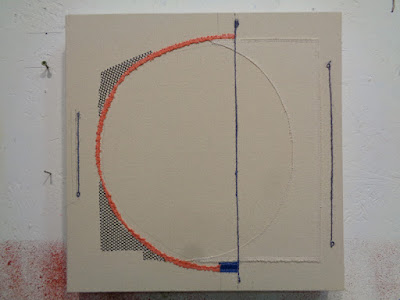I have a type of very focussed multiple attention span in the studio. Lately I've been engaged with three different but connected streams of work: Large oil paintings, small acrylic paintings, and poured-paint paintings. All exploring circles, ellipses, arced lines and shapes.
I've begun making some paintings based on the small stitched pieces of my recent Fragile Planets installation. Fragile Planets received a very enthusiastic response from gallery-goers, and then it sort of went underground for a bit. Now it is resurfacing in a further incarnation.
Above: stitched canvas 16x16"
Below: detail bits of three finished acrylic paintings
The leftover acrylic paint is not wasted! No, it is more fun and productive to pour leftover paint onto pieces of canvas. Sometimes the canvas is cut fresh from the roll, other times I pour the leftover paint on top of old paintings that had never made it to being stretched.
It is summer and warm, so I do this outdoors.
Then I play with my shadow.
It has been mentioned to me that the details of these poured grounds/paintings could make paintings in and of themselves. Perhaps I will go there in future, and perhaps not.
Once in awhile, with just a few tweaks a finished painting emerges from the layers of pours. When that happens I get excited. Then I have to restrain myself from trying to make more of my pours into finished paintings, because this type of painting has to feel particularly effortless in order to be true.
It can be the most difficult thing in the world to do something effortlessly and well. It is a type of freedom that requires great and concentrated focus, often flying in the face of an innate human urge to define, classify, produce calibrated results.
And there you have the fundamental discipline of being an artist.











4 comments:
Oh, I do love these pieces. I'm particularly drawn to the stitched ones, but those poured pieces have a wonderful quality about them as well. I have great respect for your ability to bring focus to a studio art practice.
Moving toward the fall equinox now - your days are growing shorter.
dc
Hi dc,
Yes, shorter days & slightly cooler temperatures, which I for one can appreciate. I love autumn. Thanks for commenting on my blog. As for studio focus, well, my life is comparatively simple: no kids or even pets, no big family or other work obligations, so my main focus can be my studio work.
HOWEVER whether or not a person has the total focus dedication at all times, I strongly believe that any & all creative endeavours, at whatever time and place in our lives, is not only valid but of utmost importance. We need to share who we are, our insides, particularly in a world which focusses almost exclusively on our outsides. Don't you think so too?
School season is close on the horizon now and I'll be teaching the kids again, which is wonderful and energizing (if a bit physically tiring), but also at times feels like an interruption of flow in the studio. Mostly, though, teaching is energizing, and I'm thankful that I can do this work which helps to pay the bills.
xoxoxo
V
Hope you're well and enjoying life!
Love this. The idea of stitching on paintings just enthralls me. Amazing, and of course I have become circle obsessed because of all of the astounding things you do with circles. I know what you mean, when a work skips out of you, it is a great feeling, and it's important to trust that.
XOXOXOXOXO Barbara
Thank you Barbara, from one admiring artist to another!
xoxoxo
V
Post a Comment